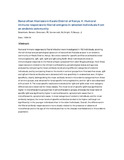| dc.description.abstract | Humoral immune responses to filarial infection were investigated in 162 individuals, covering the full clinical and parasitological spectrum of bancroftian filariasis as seen in an endemic community of Kwale District, Kenya. Sera were tested for specific antifilarial antibodies (total immunoglobulins, IgM, IgGl, IgG4 and IgE) using ELISA. Most individuals showed an immunological response to the filarial antigen (prepared from adult Brugia pahangi). How these responses were related to the clinical manifestations, parasitological status and age was analysed by comparing the mean antibody levels among different categories of endemic individuals, and by comparing these to the levels in control groups from filariasis-free areas. IgM and IgE anti-filarial antibodies were detected with low specificity in unabsorbed sera. A higher specificity, clearly distinguishing the mean antibody levels in the endemic categories from those of control groups, was obtained for total specific immunoglobulins, and for IgE in sera absorbed with protein A. The most specific results were obtained for IgGl and IgG4; clear inter-category differences were observed for these classes. The mean level of specific IgG4 was significantly higher in microfilaraemic groups than in amicrofilaraemic groups, whereas the mean level of specific IgGl was significantly higher in amicrofilaraemic, symptomatic cases than in microfilaraemic, symptomatic cases. In most categories of endemic individuals, and for most antibody isotypes, the mean levels of specific antibodies tended to be higher (although not significantly) in the younger individuals than in the older individuals. Overall, the differences in the filarial antibody responses were more closely related to the presence or absence of microfilariae and to the age of the individuals than to the disease manifestations in this endemic population. | en |

